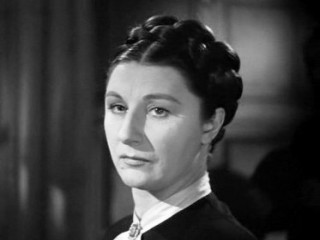
Judith Anderson biography
Date of birth : 1898-02-10
Date of death : 1992-01-03
Birthplace : Adelaide, Australia
Nationality : Australian
Category : Famous Figures
Last modified : 2011-08-23
Credited as : Actress, tragic heroines, Santa Barbara
Judith Anderson rose to prominence on stage and in films in America in the 1930s and 1940s, playing classical tragic heroines and dark character roles. She was probably most widely known for her film portrayals of the soap opera matriarch Minx Lockridge on NBC's Santa Barbara (1984-1987) and as a Vulcan High Priestess in Star Trek III: The Search for Spock.
Judith Anderson was born Frances Margaret Anderson in Adelaide, Australia, on February 10, 1898, to an English mother and Irish father. The latter had made (then quickly lost) his fortune in silver mines while his four children were still young. At an early age Judith was given lessons in singing and piano, but displayed a talent for elocution. After winning top honors in an elocution contest for recitation, she signed on as an actress with a touring Australian stock theater company, making her professional debut in 1915 in Sydney in A Royal Divorce at the age of 17. Three years later she and her mother traveled to America to explore the possibilities of success in the fledgling American film industry. But a letter of introduction from her Australian theatrical managers to movie director Cecil B. DeMille did little to impress. Anderson's features (not "cute" or "beautiful" by Hollywood standards) and her diminutive size (5 feet 4 inches) made her a liability, rather than an asset, to film acting at that time.
The mother and daughter pair then made their way across country to New York City to attempt to break into the legitimate theater. Judith would travel from one producer's office to the next looking for work, while her mother eked out a living for them as a seamstress in their one-room apartment. As luck would have it, Anderson was "discovered" by the director of the Emma Bunting Stock Company when, tired and ill from the flu, she collapsed in a producer's waiting room. Passing by, he offered her a place in the acting company at $40 a week (although she had to supply her own costume). Within a year's time she was making $50 a week and playing leading roles. In 1920 she performed in a tour of the play Dear Brutus with one of the major stars of the day, William Gillette. Anderson had her first success on Broadway as Elsie Van Zile in a melodrama called Cobra (1924).
In the late 1920s and early 1930s she established herself as an actress of great emotional depth in serious dramas such as Eugene O'Neill's Strange Interlude and Mourning Becomes Electra, Luigi Pirandello's As You Desire Me, and Zoë Adkin's The Old Maid. She played Gertrude in Guthrie McClintic's production of Hamlet with John Gielgud in the leading role and Lillian Gish as Ophelia in 1937 as well as Lady Macbeth to Maurice Evans' Macbeth on Broadway in 1941 (a role she was to repeat several times both on stage and on television).
Perhaps Anderson's greatest stage triumph was the mythic, evil seductress Medea, which she first performed in 1947 in an adaptation especially written for her by her lifelong friend poet Robinson Jeffers (and for which she won a Tony award in 1948). One critic called her Medea "pure evil, dark, dangerous, cruel, raging, ruthless. From beginning to end she maintains an almost incredible intensity … she moves with such skill through explored regions of pain and despair that she can hold her audience in suspense throughout the evening."
Anderson's film career initially began in 1933, when she played a gangster's moll in Blood Money. She did not adjust well at first to the demands of film acting, but received an Oscar nomination in 1940 for her portrayal of the menacing housekeeper Mrs. Danvers in Alfred Hitchcock's mystery Rebecca. Her major films include Kings Row (1942), Stage Door Canteen (1943), Laura (1944), And Then There Were None (1945), The Furies (1950), Salome (1953), The Ten Commandments (1956), and Cat on a Hot Tin Roof (1958).
Her favorite actress was Sarah Bernhardt, who, like Anderson, excelled in dramatic roles and continued to act well into her seventies. In 1970 Anderson toured in a production of Shakespeare's Hamlet, playing the title role of the young, brooding prince at the age of 72. She was much maligned by critics in this endeavor, who, in this day and age of realism, could not overcome the anachronism of having someone of Anderson's age and gender play the role. Responding to questions about accepting roles in soap operas and popular films, she noted in an interview that "Bernhardt … would have accepted a daytime drama if they offered her one."
Anderson's acting can be described as very intense, focused, and controlled. She belonged to a generation of American actresses that included Ethel Barrymore, Helen Hayes, Laurette Taylor, and Katherine Cornell, women who represent the "classic" school of American acting, between the histrionic melodramas of the 19th century and the realistic "kitchen sink" dramas of the 20th. Her early training and success in elocution produced a mellifluous speaking voice, rich in tone and depth, which one critic referred to as "heavy" and "haunted," belonging "in the National Archives as a permanent treasure."
She was named Dame Commander of the British Empire in 1960 by Queen Elizabeth II for her outstanding contributions to acting. She also won two Emmys for the two performances as Lady Macbeth she gave on television (1954, 1960) and another Tony award in 1982 playing the nurse to Zoë Caldwell's Medea. Anderson was married and divorced twice. She died of pneumonia at her beloved California home on January 3, 1992 at the age of 94.
















